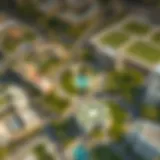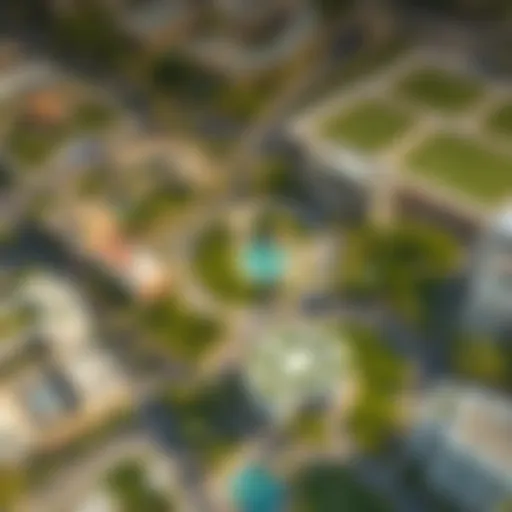Exploring Dubai's Cycling Tracks for Sustainable Living
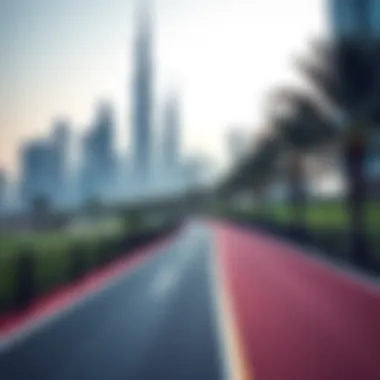
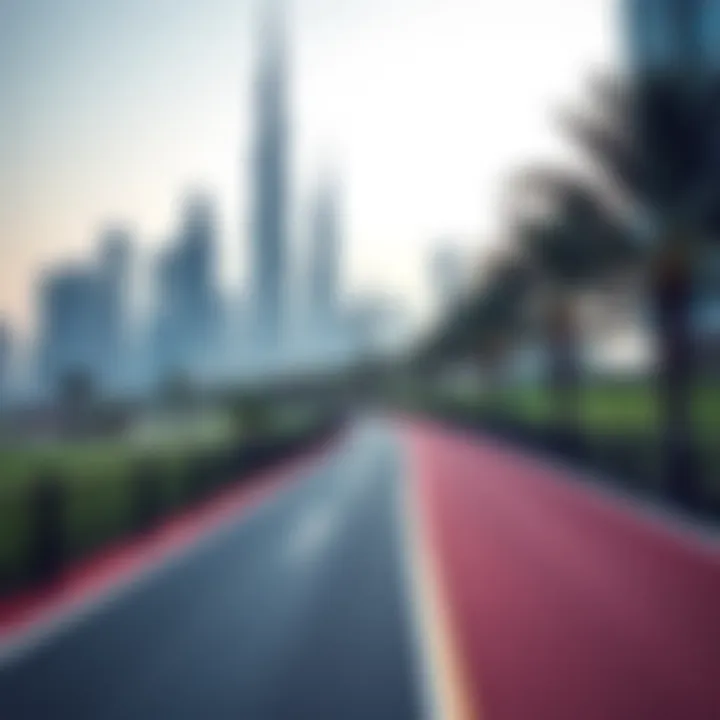
Intro
Dubai, a city known for its opulence and cutting-edge infrastructure, is rapidly evolving as a haven for cyclists. In recent years, the emirate has made significant strides in promoting cycling as both a mode of transportation and a recreational activity. This shift reflects not just a change in lifestyle but also aligns with Dubai's commitment to sustainability and a healthier urban environment.
With the sun casting long shadows on its sleek skyscrapers and the warmth of its deserts, it's crucial to understand the dynamics behind the growing cycling culture. As we pedal through this exploration, we’ll navigate the various tracks that weave through Dubai's urban landscape. This is more than just an excursion; it's about understanding the sophistication of cycling routes designed to ensure accessibility for all.
A comprehensive look will reveal not only the architectural and logistical aspects of these tracks but also their role in enhancing community well-being. From scenic loops around parks to extensive paths that mimic arteries in the city’s fabric, cycling in Dubai holds a promise of both leisure and practicality. The interplay of nature and urban life showcases how cycling can contribute to a richer, more integrated experience for residents and visitors alike.
Get ready to delve deeper into how these cycling paths are shaping Dubai's identity, enhancing connectivity, and creating spaces where people can unwind while being active. Let's gear up and roll into this comprehensive overview.
Prelims to Cycling in Dubai
Cycling in Dubai has rapidly transformed from a niche activity to a burgeoning trend, embodying not only a recreational pastime but also an integral part of the city’s vision for sustainable urban mobility. The rise in cycling's popularity signals a shift in lifestyle choices among residents and visitors, reflecting a growing awareness of health, environmental concerns, and the importance of community. This introduction sets the tone for a detailed exploration of cycling tracks in the emirate, shedding light on their significance in shaping a more active and eco-friendly urban landscape.
The Rise of Cycling as a Popular Activity
Over the past decade, cycling has gained significant traction among various demographics in Dubai. Traditionally dominated by cars, the city is now slowly embracing two-wheelers with open arms, reflecting a societal attitude shift towards greener commuting alternatives. Free of the constraints of fuel costs and traffic congestion, cycling offers a refreshing escape for many, making both the morning ride to work and evening spins in the open air popular. Prominent annual events, such as the Dubai Cycling Challenge, have also played a crucial role in raising awareness and engaging the community, drawing both seasoned cyclists and novices alike into the fold.
The emergence of dedicated cycling path infrastructure, such as the Al Qudra Cycling Track, has further enhanced accessibility for cyclists, affirming their importance in the transportation ecosystem. Moreover, cycling clubs and social groups have sprouted throughout the city, fostering a sense of camaraderie among cycling enthusiasts.
Context of Urban Mobility and Sustainability
As urban centers globally grapple with the challenges associated with congestion and pollution, cities like Dubai are pioneering cycling as a vital component of sustainable urban mobility. The emphasis on cycling dovetails with the broader UAE initiative to nurture a more sustainable environment, with the government advocating for practices that reduce the carbon footprint. By investing in cycling infrastructure, the authorities are not just encouraging leisure, but promoting a lifestyle that reduces reliance on motor vehicles.
In this respect, cycling contributes not only to personal fitness but also to the collective wellbeing of the community by promoting cleaner air and less crowded streets. In researching cycling options, residents discover not just pathways and lanes, but rather a lifestyle that pairs mobility with sustainability.
"Embracing cycling in urban planning is not merely about individual commute choices; it's a strategic approach to shaping the future of urban environments."
Cycling's rise in Dubai demonstrates a commitment to an innovative, interconnected, and sustainable city, making it a pertinent subject for various stakeholders. As we dig deeper into the cycling tracks available, it becomes essential to recognize the underlying philosophies driving this shift and the implications for potential residents, investors, and urban planners alike.
Overview of Dubai’s Cycling Tracks
Dubai's cycling tracks play a pivotal role in the city’s evolving landscape, reflecting a growing recognition of cycling not just as a recreational activity but as a genuine mode of transportation. The proliferation of these tracks supports a vibrant cycling culture that resonates with both locals and tourists alike, creating avenues for health, leisure, and environmental sustainability. With the city’s rapid urban development and increasing vehicle congestion, establishing effective cycling infrastructure is not merely beneficial; it has become essential.
Key Features of Cycling Infrastructure
The cycling infrastructure in Dubai is designed with meticulous attention to detail, combining functionality with aesthetic appeal. Several elements stand out:
- Dedicated Lanes: Each route is equipped with dedicated bicycle lanes, delineated from vehicular traffic, enhancing safety for cyclists. This segregation is vital, making riders feel secure as they navigate through the city's busy streets.
- Well-Maintained Pathways: The tracks are constructed with high-quality materials, ensuring a smooth ride while withstanding the climate's harsh conditions. Regular maintenance checks keep these paths clear of debris and potential hazards.
- Rest Areas and Amenities: Strategically placed rest areas allow cyclists to take breaks, hydrate, and socialize. Facilities like bike racks, water stations, and toilets are gradually being introduced, fostering a welcoming environment for all cycling enthusiasts.
- Signage and Navigation: Clear signage throughout the tracks assists cyclists in navigating their routes easily. Distinct markers indicating distances and direction ensure that even newcomers can explore without stress.
- Integration with Public Transport: Many tracks connect seamlessly with public transportation hubs, making it easier for cyclists to combine cycling with bus and metro travel. This integrated approach promotes a holistic view of urban mobility.
Types of Cycling Tracks Available
Dubai offers an array of cycling tracks catering to diverse preferences and levels of expertise. Here’s a closer look at some notable types:
- Paved Recreational Trails: These trails are designed for leisurely rides and family outings, making them ideal for casual cyclists and children. They are often set in picturesque environments, providing an enjoyable backdrop.
- Road Cycling Tracks: More suited for seasoned cyclists, these tracks emphasize speed and distance. Often found along major roadways, they allow enthusiasts to challenge themselves and build endurance.
- Mountain Biking Paths: For those seeking adventure, specifically designed mountain biking trails are available. These paths integrate challenging terrains, perfect for thrill-seekers looking to enjoy a vigorous workout.
- Urban Connector Routes: Created to enhance access to key city areas, these routes facilitate daily commuting for residents. They often run parallel to major roadways, providing a practical way for individuals to bike to work or school.
"Cycling isn't just a hobby; it's a lifestyle reflecting a commitment to health and sustainability."
In summary, understanding the cycling tracks in Dubai reveals a multifaceted landscape that caters to different needs and promotes a sustainable urban lifestyle. With its unique combination of infrastructure, recreational offerings, and community initiatives, Dubai is firmly positioning itself as a cycling-friendly city.


Popular Cycling Routes in Dubai
Cycling in Dubai isn’t just a hobby; it's blossoming into an essential part of city life. The routes available serve various purposes, from leisurely rides to intense workouts, making them vital for both residents and visitors. Each path offers a unique glimpse of Dubai's landscape, showcasing its mix of modern architectural wonders and natural beauty. Additionally, these cycling routes help to enhance community engagement, where cyclists from different walks of life come together, promoting a sense of unity through shared interest in health and environment.
Al Qudra Cycling Track
Arguably one of the crown jewels of Dubai's cycling scene, the Al Qudra Cycling Track stretches over 86 kilometers through the scenic desert landscape. With its well-maintained asphalt surface, this track caters to both novice and experienced riders. Access to facilities such as rest areas, hydration stations, and even bike rentals adds convenience to the experience. The view along the track is nothing short of stunning, especially during early morning or late afternoon rides when the golden desert hues are at their most captivating.
What sets Al Qudra apart is its combination of physical challenge and aesthetic pleasure. Riders can enjoy wildlife such as gazelles, camels, and a variety of birds native to this area.
"Cycling at Al Qudra is like pedalling through a painting; every turn reveals a new shade of the desert," says one local enthusiast.
It's also designated a major part of Dubai's efforts to promote outdoor activities, which aligns with the city’s broader goals of enhancing public health and reducing road congestion.
Dubai Canal Bike Track
The Dubai Canal Bike Track offers a refreshing urban experience. Following the banks of the vibrant Dubai Canal, this route attracts cyclists who love the buzz of city life while embracing the beauty of water. Stretching about 13 kilometers, riders can enjoy the soothing sounds of flowing water alongside views of stunning skyscrapers and lush landscaping that adorns the canal.
The proximity to popular food outlets and recreational parks enables cyclists to take breaks and enjoy the ambiance. This track is particularly appealing for families and social gatherings, as it combines biking with accessibility to numerous amenities. The ride culminates at the exciting Dubai Water Canal, where one can stop and take in the sight of the dazzling waterfall and misty lights.
Jumeirah Corniche
The Jumeirah Corniche presents a different flavor of cycling in Dubai. Spanning approximately 14 kilometers along the picturesque Jumeirah beach, this track is perhaps the most scenic one. Cyclists here are treated to panoramic views of the sea and the iconic Burj Al Arab looming majestically in the background. The pleasant sea breeze makes this route particularly enjoyable during the cooler months.
Families and casual riders frequent this path due to its easy terrain and family-friendly atmosphere. It’s not uncommon to see people cycling with kids, or taking a leisurely ride and stopping to grab ice cream or a coffee at the beach cafés. Meanwhile, dedicated lanes for pedestrians ensure that all users can navigate safely, enhancing the overall cycling experience.
In summary, the cycling routes in Dubai are more than just pathways for bikes. They represent a lifestyle choice adopting health, community bonding, and appreciation of nature amid an urban masterpiece. Each route has its unique charm, encouraging riders to explore and appreciate the multifaceted culture and environment that Dubai offers.
Health and Environmental Impacts
Health and environmental impacts play a crucial role in the conversation around cycling in Dubai. As urban areas continue to grow, understanding how cycling contributes to both personal well-being and environmental sustainability becomes increasingly essential. In this context, cycling not only serves as an enjoyable pastime but also acts as a catalyst for improving physical health and reducing the urban carbon footprint.
Physical Benefits of Cycling
Cycling is recognized as one of the most effective forms of exercise, offering numerous physical benefits. Engaging in cycling enhances cardiovascular health, strengthens muscles, and improves overall fitness levels. Regular cyclists often experience:
- Better Heart Health: Riding a bike increases heart rate and promotes cardiovascular endurance. This is particularly valuable in an urban setting where sedentary lifestyles have become the norm.
- Weight Management: Cycling burns calories and contributes to weight control, an important consideration given the rising rates of obesity in many cities, including Dubai.
- Strengthened Muscles: Not only does cycling develop leg muscles, but it also engages the core and improves overall body strength. Many individuals find that cycling helps tone their body effectively.
- Enhanced Mental Health: Physical activity boosts mood by releasing endorphins. Cyclists often report feeling more energized and less stressed after a ride, making it an effective way to unwind.
Cycling may help reduce anxiety and depression, showcasing that it is not just good for the body but also beneficial for mental well-being.
Reducing Carbon Footprint
Promoting a lifestyle that includes cycling directly correlates with decreasing the carbon footprint in urban areas. In a booming city like Dubai, where traffic congestion frequently becomes an issue, cycling emerges as an eco-friendly alternative to motor vehicles. Here are some key points to consider:
- Less Emission: Cyclists contribute to a substantial reduction in greenhouse gas emissions when choosing to bike instead of drive. This shift invariably improves air quality, making for a healthier city environment.
- Resource Efficiency: Cycling requires minimal resources compared to motor vehicles. It does not demand fossil fuels and utilizes less energy overall, proving a more sustainable mode of transport.
- Promotion of Green Spaces: By encouraging cycling initiatives, cities may also cultivate more parks and natural areas, fostering a relationship between urban living and nature. This could lead to improved biodiversity and more opportunities for community recreation.
"Cycling is not merely a mode of transport, but a way to foster healthier communities and a cleaner planet."
The commitment to cycling as a viable means of urban transport, particularly in Dubai, not only benefits cyclists personally but also contributes to broader environmental aims. By continuing to invest in supportive infrastructure and community initiatives, the city positions itself at the forefront of sustainable urban living.
Cycling Events in Dubai
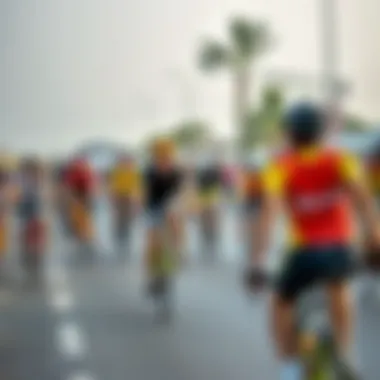
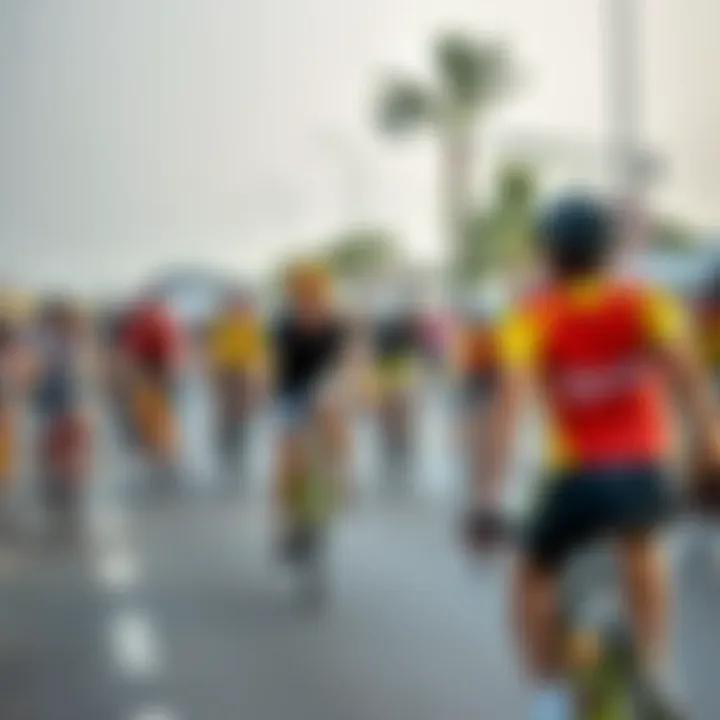
Cycling events play a pivotal role in nurturing a vibrant cycling culture in Dubai. These events not only attract local riders, but they also draw in tourists and enthusiasts from all over the globe, showcasing the city’s dedication to promoting physical fitness and environmental sustainability. In this section, we will delve into the major types of cycling events held in Dubai, focusing on annual competitions and community rides.
Annual Cycling Competitions
Every year, Dubai hosts a plethora of exciting cycling competitions that cater to a range of skill levels and ages. These events vary from professional races to amateur engagements, offering something for everyone. The Dubai Tour is one of the most significant races, featuring elite cyclists from different corners of the world. With its challenging routes and breathtaking scenery, the event not only tests the stamina of participants but also highlights the city's stunning skyline.
In addition to the Dubai Tour, many local races are organized throughout the year, such as the Al Qudra Cycling Challenge. This event specifically takes place on the well-known Al Qudra Track, drawing hundreds of cyclists and fostering camaraderie among participants. The thrill of competing against fellow riders, alongside the backdrop of the Arabian Desert, tends to create an electrifying atmosphere.
Benefits of Participating in Competitions
- Skill Development: Competing offers cyclists a chance to hone their skills and learn from others.
- Community Building: These competitions foster a sense of community among participants, encouraging friendships and networking opportunities.
- Health Awareness: They promote an active lifestyle, leading to better physical health and awareness of cycling benefits.
Community Rides and Initiatives
Community rides are another vital aspect of Dubai's cycling events. Regular group rides are arranged by local cycling clubs, allowing individuals of varying experience levels to get involved. These rides are frequently organized for fun and leisure, encouraging families and friends to participate together.
An excellent example is Ride Dubai, a community initiative focused on engaging new cyclists and promoting cycling as a form of healthy leisure. These rides often take place in family-friendly locations, such as the Dubai Marina or the Jumeirah Beach Residence, making it accessible to many.
Moreover, Dubai’s government has implemented programs to support these community initiatives, ensuring that there are ample facilities and safety measures in place. The critical takeaway here is that community rides not only promote cycling but also emphasize social interaction, building a network of supportive cyclists.
Advantages of Community Initiatives
- Accessibility: They allow newcomers to feel welcomed and less intimidated by the sport.
- Social Interaction: Builds relationships among like-minded individuals passionate about cycling.
- Encouragement: The supportive environment can greatly motivate individuals to pursue cycling more seriously.
"Cycling events not only energize the cycling scene in Dubai but also pave the way for a healthier lifestyle for many residents and visitors alike."
Challenges and Considerations
As cycling continues to grow in popularity within Dubai, addressing the challenges and considerations surrounding this mode of transportation is paramount. Recognizing these obstacles helps to foster an environment where cyclists can thrive and encourages more residents and visitors to embrace this sustainable practice. Awareness of safety concerns and the impact of weather conditions are essential to understanding the broader context of cycling in the city. These elements are not merely hurdles to overcome; they also represent opportunities for improvement, education, and enhanced urban planning.
Safety Concerns for Cyclists
Cycling safety is a critical issue that demands attention from city planners, cyclists, and other road users. The significant increase in cycling enthusiasts has highlighted an urgent need for clear guidelines, proper infrastructural designs, and community understanding in order to promote safe riding experiences.
- Infrastructural Design: Properly designed bike lanes, clearly marked traffic signs, and well-maintained paths can significantly reduce accidents. Iconic cycling tracks, like the Dubai Canal Bike Track, need ongoing maintenance and protection from motor vehicles to ensure cyclists are safe and free from hazards.
- Awareness and Education: It's crucial for all road users to understand the rules related to cycling. This includes knowing how to share the road effectively. Implementing educational programs that teach cyclists and motorists about safe riding and driving practices can help minimize risks.
- Safety Gear: Encouraging cyclists to wear helmets and other protective gear can make a substantial difference in outcomes during incidents. It's a simple yet effective way to enhance safety for everyone on the road.
"Safety is not just a priority; it’s a community commitment that looks out for every individual’s well-being."
Weather Conditions and Their Impact
The weather in Dubai can be quite extreme, posing additional challenges for cyclists. The harsh climate affects not just the comfort of riders but also their safety and performance. Understanding how weather conditions influence cycling can help cyclists prepare better and make informed decisions about when and where to ride.
- Heat Considerations: During the summer months, temperatures often soar, sometimes reaching as high as 50 degrees Celsius. Cycling in such heat can lead to heat exhaustion or heatstroke. Riders must adjust their schedules, opting for early morning or late evening rides to avoid the peak sun exposure. Staying hydrated is also key.
- Wind Conditions: Strong winds, particularly in open areas like Al Qudra, can make cycling challenging. Riders should be aware of wind patterns as they can impact balance and cause fatigue more swiftly than usual.
- Rain and Humidity: Although not frequent, rainfall can cause slippery roads and reduce visibility. Cyclists may have to navigate puddles and other water-related obstacles that could lead to accidents. Riding during high humidity can also be exhausting and increase the risk of dehydration.
By acknowledging these weather considerations, cyclists can make smarter choices. Being proactive about safety measures, such as choosing appropriate days and times for rides, is essential for enjoying a safe and pleasant cycling experience in Dubai.
Government Support and Policies
As cycling gains traction as a favored mode of transport in Dubai, the role of government support becomes increasingly critical. Policies and initiatives framed by local authorities not only nurture the cycling culture but also establish a robust framework for sustainable urban mobility. This commitment from the government reflects a recognition of cycling’s potential to ease traffic, lower pollution, and promote a healthy lifestyle among residents.


Initiatives to Promote Cycling
Government initiatives aimed at promoting cycling are multifaceted. One of the standout measures is the annual bike month, which encourages citizens and expats alike to take to the streets on two wheels. Events like the Dubai Fitness Challenge have become a popular platform, demonstrating the city’s investment in fostering an active lifestyle. Authorities have collaborated with various organizations to host community biking events that provide free rentals and guided tours, making cycling more accessible to all.
Moreover, campaigns educating residents on road safety are crucial. Workshops detailing safe cycling practices help reduce accidents and build a culture of mutual respect between cyclists and motorists. With these supporting activities, the government sends a clear message: cycling is not just a hobby, but an integral part of Dubai's transport agenda.
Investment in Cycling Infrastructure
Investment in cycling infrastructure is another pillar of government policy, essential for creating a cyclist-friendly environment. This includes extensive development of dedicated bike lanes, which are both separate from vehicular traffic and aesthetically designed to fit within Dubai’s urban landscape. Additionally, strategic placement of bike racks at key locations encourages people to cycle for commuting rather than solely for leisure.
The government’s foresight can be seen in the plan for expanding the cycling track network to cover more areas, including residential neighborhoods and business districts. This will not only provide safe routes for cyclists but also integrate biking into the daily lives of residents.
In recent years, substantial funding has been allocated to enhance these facilities, with efforts to make them sustainable and environmentally friendly. By promoting biking through infrastructure investment, Dubai is setting a precedent in urban planning that prioritizes not only efficiency but also quality of life.
"A strong cycling infrastructure isn't just a luxury; it's a necessity for a thriving urban environment."
Future of Cycling in Dubai
The future of cycling in Dubai holds a promising potential that not only reshapes the leisure landscape but also aligns with the city's broader vision of sustainability and urban mobility. As residents and visitors increasingly turn to cycling as a primary mode of transportation, the infrastructure and policies surrounding this activity need to evolve. This evolution is crucial because it not only enhances accessibility for cyclists but also contributes significantly to the reduction of urban congestion and carbon emissions.
Expected Infrastructure Developments
Plans for enhancing the cycling infrastructure in Dubai are already underway. Authorities have acknowledged the growing demand and are working on several key developments that will dramatically improve cycling conditions in the city. Among these improvements, the following initiatives stand out:
- Expanded Cycling Tracks: The government intends to expand existing routes and develop new tracks, ensuring that cyclists can travel safely across different areas of the city.
- Improved Signage and Wayfinding: Clear signs and maps will be implemented to help cyclists navigate their routes more effectively. This will be particularly beneficial for newcomers to the city.
- Bike Sharing Systems: The introduction of bike-sharing programs is also in consideration. This service can provide more flexibility for those who might not own a bicycle but want the convenience of cycling on occasion.
- Integration with Public Transport: Access to bicycle racks on public transport will be increased, enabling a seamless transition for commuters. This integration encourages more people to cycle part of their journey.
The expected upgrades will significantly boost not just the number of cyclists but also the overall cycling culture within Dubai.
Envisioning a Cycling-Friendly City
Imagining a cycling-friendly city is about more than just expanding routes; it's about cultivating a community ethos that embraces and encourages cycling as an essential part of urban life. A truly cycling-friendly Dubai would incorporate several elements:
- Dedicated Cycling Zones: Creating neighborhoods where cars are limited or banned will encourage more people to cycle instead of driving, enhancing safety and reducing road-related accidents.
- Community Engagement Programs: Initiatives to engage the local population, like cycle-friendly festivals or workshops on bike maintenance, can create a sense of belonging and encourage participation.
- Enhanced Safety Measures: Installing barriers between cycling lanes and motor vehicle traffic, along with increasing visibility through lighting and reflective materials, would significantly enhance safety for cyclists.
- Eco-Friendly Environmental Policies: Policies that promote sustainability will also benefit cyclists. Investments in renewable energy for bike stations and a focus on reducing the carbon footprint of buildings can complement a cycling culture.
By focusing on these aspects, Dubai can cultivate an environment where cycling becomes not just a viable alternative means of transport but a way of life. This vision reflects a forward-thinking approach which not only serves current residents but is also attractive to potential investors and property developers looking at the vibrant lifestyle Dubai has to offer.
Building a cycling-friendly environment isn't just a luxury; it's an investment in the future of urban living.
Assessing these developments critically will provide insights into how sustainable practices are interwoven with urban growth. The commitment to cycling is a testament to Dubai's ambition to lead the way in modern urban mobility.
Culmination
Cycling in Dubai is more than just a mode of transport; it represents a forward-thinking approach to urban living. With the city increasingly embracing sustainability, cycling tracks have emerged as essential components of a greener future. The significance of cycling within this expanse extends to various aspects, from promoting public health to aligning with the UAE's sustainability goals.
Summary of Key Points
Throughout this exploration of cycling in Dubai, we've highlighted several critical elements:
- Accessibility: The cycling tracks are designed to cater to a wide array of cyclists, from beginners to seasoned riders, offering safe and dedicated routes.
- Health Benefits: Engaging in cycling contributes substantially to physical health, helping to reduce obesity rates and encouraging a more active lifestyle.
- Environmental Impact: By promoting cycling, Dubai aims to reduce its carbon footprint, aligning with broader environmental strategies. This shift plays a vital role in improving air quality and reducing traffic congestion.
- Infrastructure Investment: The government’s commitment to developing cycling infrastructure is evident through various initiatives and policies, which enhance the cycling experience in city.
- Community Engagement: Cycling events foster community spirit, bringing people together and creating a vibrant social atmosphere centered around a common interest.
Encouragement for Exploration
As cyclists or individuals considering taking up the hobby, it is essential to embrace the diverse cycling opportunities presented in Dubai. The tracks are not just routes; they are gateways to discovering urban landscapes, while also being a part of an ever-evolving cycling culture. Whether you’re cruising alongside the stunning Dubai Canal or tackling the scenic Al Qudra, every ride offers a fresh perspective of the city.
The benefits extend beyond just physical exercise. Participating in community rides or events encourages social interaction while contributing to a collective movement towards sustainable urban living. It’s not just about the destination, but the journey as well—so grab your bike and explore!
“Cycling in Dubai opens doors to new experiences, connecting people through a shared passion for health and sustainability.”
